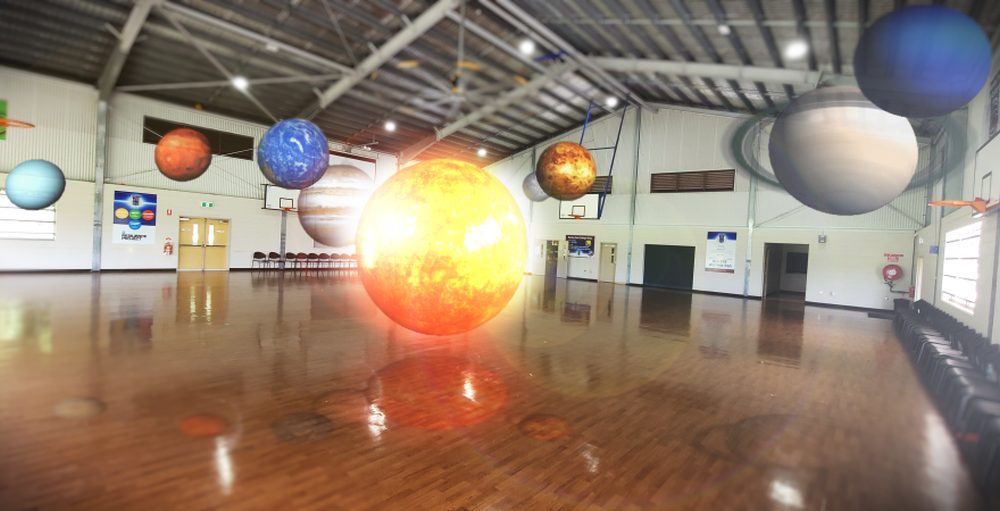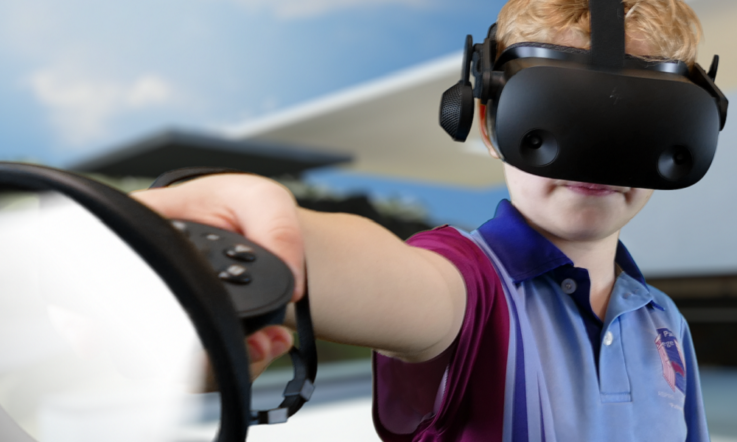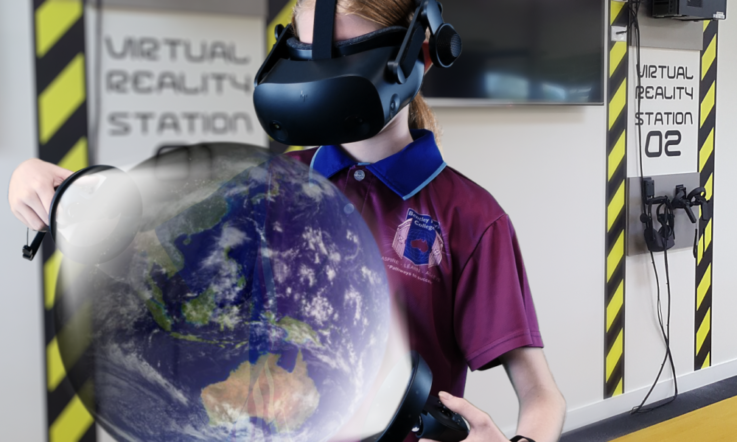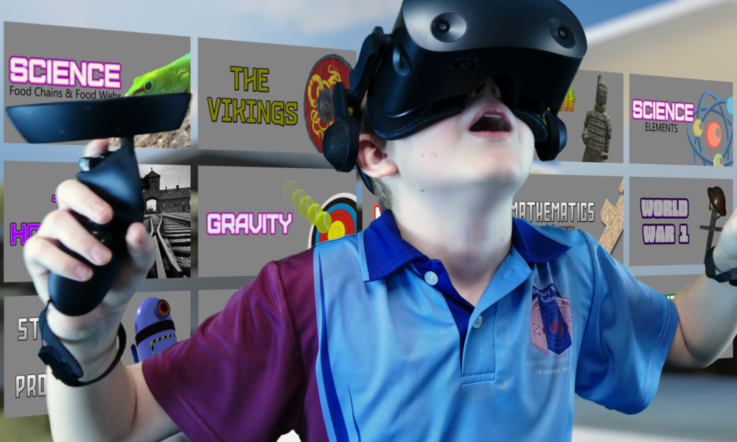It’s hard to believe that it’s 2 years since we shared our VR Learning & Design Hub story with Teacher magazine readers! Since that time, we have seen a steady growth in the use of virtual reality as a tool for learning and teaching.
Working closely with the VR Hub, an enthusiastic and collegial community of VR schools has emerged across Queensland Department of Education schools and the wider Australian educational community. However, frequently our primary colleagues plead ‘What about primary students? How can they access the benefits of immersive technology in their learning?
Well, we have heard, and we have responded! After exploring and examining Augmented Reality (AR) and its uses, we are convinced that – when fully embedded and aligned with the Australian Curriculum – AR can be an extraordinary tool for learning, particularly suited to use by primary-aged students. As such, the Hub has now produced curriculum-aligned AR modules for use in Queensland Department of Education primary schools.
What is Augmented Reality?
Augmented Reality is ‘An interactive experience of a real-world environment whose elements are “augmented” by computer-generated perceptual information,’ (Galati et al., 2019). In other words, images are overlaid on those in the real world. A custom-designed marker, which operates just like a QR code, triggers the AR software and allows the user to ‘see’ the computer-generated world and the real world in the same place, at the same time. Some AR software has the capacity to track real physical objects and can produce larger scale images without the use of a marker.
How does AR differ from Virtual Reality?
Unlike VR, AR can be accessed through a range of technological devices such as tablets, smartphones, computers and smart whiteboards. This multiplicity of potential AR devices has a significant cost advantage compared with VR and enables AR use in a wide variety of learning contexts.
VR and AR are both examples of immersive technology and have similarities in terms of their benefits for student learning. However, AR has significant differences from VR as succinctly outlined below:
‘Augmented reality involves experiences in which the real, physical world is augmented, overlaid with, or supplemented by technology generated imagery, like sound, video, or graphics… Virtual reality is a more immersive experience in which technology produces sensory output like sounds and images to create an imaginary world or one that mirrors a real environment,’ (Sobel, 2019).
AR does not require the use of a headset, which makes it very suitable for use with even the youngest of primary age children. The student remains in the real world, avoiding any sense of displacement or confusion. The teacher can continue classroom learning in a face-to-face environment. In addition, groups of students can work concurrently on the same task, in the same workplace.
Unlike VR, students have their hands free. They are able, therefore, to work simultaneously with other media and texts, recording their ideas, observations and notes as they navigate the AR image.
These were some of the most important features that shaped the Hub’s decision to produce curriculum-aligned AR modules for primary.
What are the educational benefits for students?
Both AR and VR have the capacity to enrich learning, enhance digital intelligence and develop practical digital skills. An overview of the research literature on Immersive Technologies identifies a comprehensive range of observed benefits for student learning (for example, Sirakaya & Sirakaya, 2019; Galati et al., 2019; Sobel, 2019; Alzahrani, 2020). It is beyond the scope of this article to provide a comprehensive exploration for each, but here’s a bullet-point list of advantages of immersive technology such as VR and AR:
- Improves understanding of complex and abstract concepts
- Student confidence grows as they concurrently experience the virtual and real worlds
- Improves retention of learning
- Improves levels of participation and engagement
- Improves student perspective, imagination and cognitive ability
- Suitable for a wide range of student ages, learning styles and abilities
- Enriches student-centred learning so that students are in control of their own learning with increased autonomy
- Students can engage from their unique ability, place, and pace
- Provides instant feedback and reinforcement
- It is a hands-on experience – students learn by doing and by play
- A trial-and-error approach reduces fear of failure and increases a willingness to take risks
- Stimulates student dialogue and collaborative learning by allowing for student face-to-face contact and engagement in a common task and workspace
- Builds problem solving skills
- Allows interactive learning
- Improves understanding of concepts
- Builds a wider range of core digital skills
- Provides a model of differentiated learning that is in-built, suiting students with diverse learning needs.
If only a fraction of the above advantages were to flow into classroom experiences, students would indeed be learning beneficiaries. At the heart of AR benefits is the observation that Ayse Ülkü Kan and Erhan Özmen (2021) so beautifully express: ‘It can be said that AR technology contributes to developing a positive attitude towards the lesson by making the lesson fun and interesting, increasing the motivation and learning the concepts that are difficult to learn effectively.’
What is the teacher’s role?
The tool needs to be used by the teacher’s informed understanding of the technology and practice. As Ahmed Ashley-Welbeck and Dimitrios Vlachopoulos (2020) warn: ‘AR is a tool for learning and not the learning itself”.
Teachers readily recognise that students are often more confident and capable than the adults in their lives (including, perhaps, their teachers). However, to maximise the benefits of AR requires the commitment, openness and willingness of skilled teachers. It is they who will design the learning tasks integral to a guided inquiry pedagogical approach. They make the judgements about the inclusion of AR in their learning and teaching programs.
‘Technology can play a supporting role, positively changing the way students learn, but it cannot be called a replacement for teachers. The teacher is the one who integrates the technology into instruction by encouraging and motivating students to grasp new knowledge in their studies. Teachers utilize technology as a tool to make instruction easier and foster more interest in learning on the part of the students,’ (Hoon & Shaharuddin, 2019).
Teachers, therefore, should reasonably expect that they are provided with training in the effective use of AR. In our case, the Hub provides a Train-the-Trainer program to support schools in the upskilling and capacity building of their staff and help ensure training autonomy into the future.
Final thoughts
At the Hub, we believe the use of emerging immersive technologies such as VR and AR need to be integrated into curriculum documents, including year and unit plans. This can maximise student learning in an environment that presents them with a world of curiosity, discovery, collaboration, flexibility and adaptability to better meet their individual needs.
As Chooi Yi Wei and colleagues (2021) observe: ‘The integration of technology has transformed the learning environment into a more engaging, interactive, authentic and joyful environment.’
Let’s be clear – we are not preparing our students for a new technological world; we are preparing them for the world they experience now.
Stay tuned for the next article from Dr Susan O’Donnell and Adrian Rayner, which shares details of one of the AR modules designed and developed by the Learning & Design Hub for use by F-6 students.
References
Alzahrani, N. M. (2020). Augmented reality: A systematic review of its benefits and challenges in e-learning contexts. Applied Sciences, 10(16), 5660. https://doi.org/10.3390/app10165660
Ashley-Welbeck, A., & Vlachopoulos, D. (2020). Teachers’ perceptions on using augmented reality for language learning in primary years programme (PYP) education. International Journal of Emerging Technologies in Learning (iJET), 15(12), 116-135. https://doi.org/10.3991/ijet.v15i12.13499
Galati, F., Bigliardi, B., Deiana, A., Filippelli, S., & Petroni, A. (2019). Pros and cons of augmented reality in education. Edulearn19 Proceedings, 9165-9168. https://library.iated.org/publications/EDULEARN19/start/1375
Hoon, L. N., & Shaharuddin, S. S. (2019). Learning effectiveness of 3D hologram animation on primary school learners. Journal of visual art and design, 11(2), 93-104.
Kan, A. Ü., & Özmen, E. (2021). The Effect of Using Augmented Reality Based Teaching Material on Students' Academic Success and Opinions. African Educational Research Journal, 9(1), 273-289. https://eric.ed.gov/?id=EJ1290921
Sirakaya, M., & Alsancak Sirakaya, D. (2018). Trends in educational augmented reality studies: a systematic review. Malaysian Online Journal of Educational Technology, 6(2), 60-74. https://eric.ed.gov/?id=EJ1174807
Sobel, K. (2019). Immersive media and child development: Synthesis of a cross-sectoral meeting on virtual, augmented, and mixed reality and young children. The Joan Ganz Cooney Center at Sesame Workshop. https://joanganzcooneycenter.org/publication/immersive-media-and-child-development/
Wei, C. Y., Kuah, Y. C., Ng, C. P., & Lau, W. K. (2021). Augmented Reality (AR) as an enhancement teaching tool: Are educators ready for it?. Contemporary Educational Technology, 13(3), ep303. https://doi.org/10.30935/cedtech/10866
When you incorporate a new piece of technology into your teaching, what are the learning outcomes you hope to achieve?
How could integrating the use of AR into learning activities be used to complement a unit of work you have coming up? What are the barriers to making this happen and how could you work with your colleagues and wider networks to overcome these?



